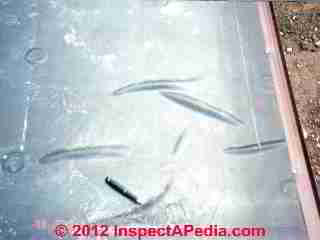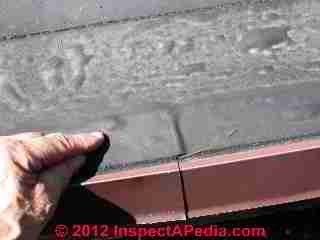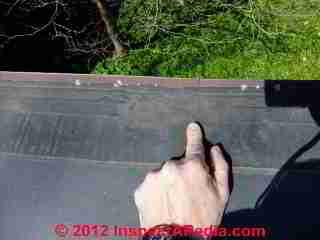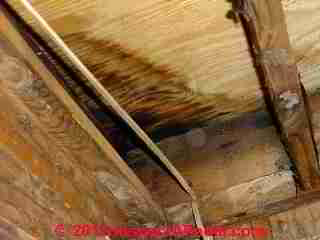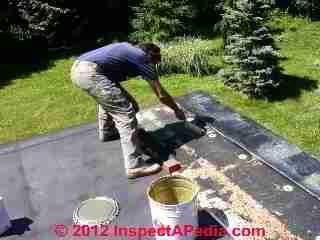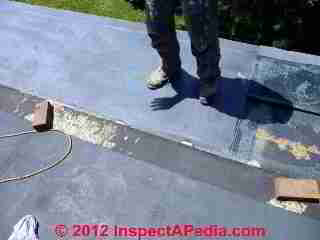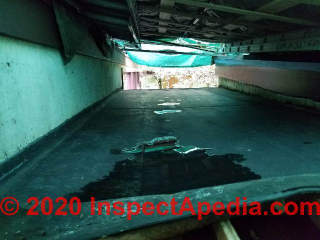 EPDM Rubber Roof Installation & Leak Repair Details
EPDM Rubber Roof Installation & Leak Repair Details
EPDM roof installation, wrinkles, flashing, leaks, coating, patching repairs
- POST a QUESTION or COMMENT about EPDM roof installation and repair procedures
Leaky EPDM rubber roof repair details:
This article describes an EPDM roof installation study & roof repair history spanning fourteen years, from original rubber roof installation (and the mistakes & shortcuts that led to leaks and trouble) to an extensive tear-off and re-roof repair that was made along the entire problem roof's lower edge.
We illustrate how choice of the wrong roof edge flashing combined with wrinkles in the original EPDM installation led to both frequent maintenance and frequent leaks in the original roof.
InspectAPedia tolerates no conflicts of interest. We have no relationship with advertisers, products, or services discussed at this website.
- Daniel Friedman, Publisher/Editor/Author - See WHO ARE WE?
Tracing the Life & Performance & Repair History of an EPDM Rubber Roof with Installation Mistakes
In general we like rubber roofing material. Modern EPDM is very reliable, tolerates sunlight, temperature variations, and properly installed, we have found it leakproof.
But the performance of an EPDM roof can be very different if the installer is not familiar with or does not follow good roofing practices.
Here we provide photos and comments following study of the performance of an EPDM roof during the first 15 years of its life, assaying the effects of mistakes and poor workmanship in the original installation.
At EPDM, RUBBER, PVC ROOFING we define EPDM, describe its properties, and discuss its typical life and warranty periods.
Article Contents
- EPDM ROOF LEAK REPAIRS
- EPDM ROOF COATING REPAIRS - separate article
Wrong roof edge flashing causes ponding
The use of an improper drip edge (gravel stop on a roof that did not use gravel ballast) can be seen at the left side of our photo.
The gravel stop "edge flashing" was nailed on top of rather than below the rubber roof material in order to allow the rubber to be lapped over the roof edge and extended an inch into the gutters (not shown) - which was not a bad idea, though the roof's success then depends on the seam sealing tape (not yet installed here) to prevent leaks at the flashing nails.
The problem with using the wrong roof edge flashing ( a flat drip edge should have been installed) was the ensuing ponding at the roof edge.
In New York where ponding of melting snow later re-freezes, the freeze/thaw action worked open seams near the roof edge, especially where a wrinkle crossed any roof edge seal or seam tape seal.
The EPDM roof shown above leaked in less than five years, and by ten years of age we found recurrent openings and leak risks at several seams in the roof as well as along the lower roof edge where that stupid gravel stop was installed.
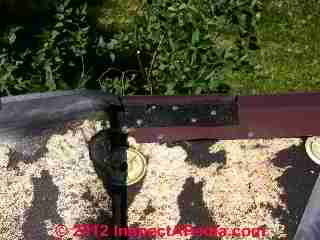
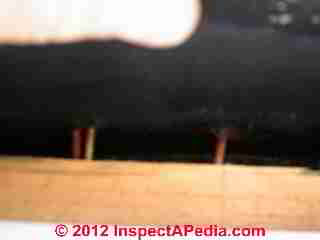
Our photos above and at left illustrate another problem with the gravel stop used at the lower edge of this EPDM roof - the metal flashing was not wide enough to reach onto the roof decking - so nails that supposedly secured the flashing to the roof were often nailed into an open space between the roof sheathing edge and the fascia board upper edge - into nowhere.
At above right the original roofer must have figured that nailing six nails into empty air would hold the gravel stop in place.
At left you can see as we lift the roof covering that the nails through that gravel stop didn't catch any wood decking.
This lack of secure nailing allowed the gravel stop to lift and buckle, increasing the roof ponding problem. At re-roof time, selecting a flat drip edge that had plenty of nailing width cured this difficulty, as we illustrate below.
Wrinkles in the rubber roof invite future seam failures
Shown during its 1998 installation above and at left, this rubber EPDM roof was installed on a New York home by a very large and busy Kingston New York roofing company. We followed the life of this roof and its leak and repair history for the ensuing 14 years and describe the results here.
The roofer also may have been in a bit of a rush. EPDM needs to be opened and allowed to relax before it is installed, and care should be taken to minimize the number and size of wrinkles in the roof during the bonding process.
A few small wrinkles in the center of a section of rubber probably won't cause much trouble, but wrinkles near EPDM roof seams are an other story, as we explain here.
EPDM Wrinkles Extend into Roof Membrane Seams, Aggravated by Gravel-Stop Ponding
Our photos below illustrate what happens when an EPDM wrinkle extends into a roof seam, and as you can see by the water stains, the gravel stop caused excessive ponding that gave frost extra time to work on and push open the seam tape near the roof edge. These seam failures (and leaks) began appearing in the rubber roof in less than five years. The photos below show the roof edge at 14 years of age.
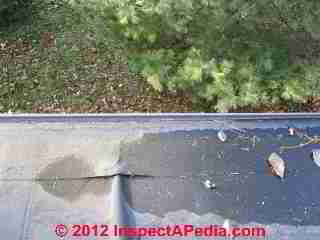
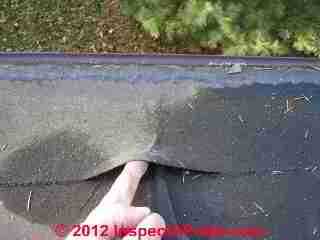
Interim Roof Repairs Avoided a Leak Catastrophe in this EPDM Rubber Roof
We made some interim EPDM roof repairs by cutting out the worst wrinkles and gluing down new sections of EPDM roofing material over the cutout. But as more of the original work deteriorated, by the end of a decade and after discovering carpenter ant infestations traced to leaks near the roof edges, we just didn't trust this roof further.
We inspected this roof every year, sealing suspect seam edges by cleaning the plies and applying rubber roof seam sealer.
But as our photo at below left illustrates, it was an endless task, exacerbated by that damnable gravel stop. At below right shows another of the original roofer's ideas for roof-wall flashing: "run it up the wall and glue the top edge of the rubber to the wood siding" - not a reliable installation and one that required constant attention.

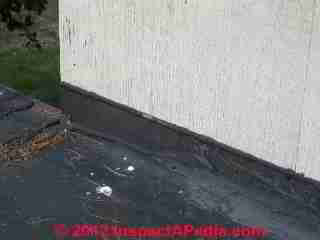
Pounding the gravel stop "flat" to allow the roof to drain provided emergency relief to slow the frost working away at seams near the roof edge, but it left a horrible, ugly, and equally stupid roof edge flashing installation.
Beneath a section of garage roofing installed by the same contractor we found leak stains during interior renovations (below right) that were traced to a roof edge (and thank you gravel stop) leak that was hard to spot from outside.
At below left I'm pointing to the soil staining in this small ponding area right over the leak shown at below right.
Below: We found a nice nest of active carpenter ants (photo) in the wall structure in this area. Leaks into an enclosed roof cavity mean that the space stays wet for a long time - a standing invitation to wood destroying insects and sometimes mold contamination as well.
Finally we just gave up on the annual cut and patch job on this roof. In 2012, after 14 years of cut and paste interim repairs, a better solution was provided by our associate, Eric Galow, of Galow Homes.
Preparing an EPDM Roof for Repair
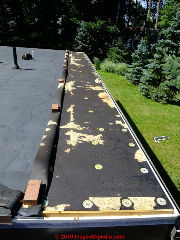
Galow's crew cut and removed the EPDM and ugly gravel stop from the entire lower roof edge, cleaning and blowing off all loose fragments of debris (below left) and peeling back a 6-inch section of the original roof that we would glue-lap over a new EPDM section of roofing along the roof's now exposed surface.
Eric also installed the proper drip edging, of adequate width to nail to the roof deck back from the edge, with a flat profile - no more raised edge gravel stop to cause roof edge ponding. (Photo at near left).
The new sections of EPDM were opened flat and allowed to relax in the incredibly hot sun (photo below left).
The new material was fully adhered in place (below right) gluing half of the length of rubber at a time then gluing and smoothing into place the second half, working with care to avoid wrinkles.
Keep the EPDM Roof Smooth and Wrinkle Free During Installation
Notice how nice and smooth the installer has made the new EPDM? No wrinkles in this fully-adhered rubber roof repair. Some roof studies we cite below note that installation of EPDM membranes that were not fully cured or that were at a very different temperature from the roof can contribute to EPDM roof failures.
At the right side of this photo you can see the second segment of rubber roofing half-bonded in place and with end seam overlap primed and ready to adhere as well. We used bricks to hold back the to-be-overlapped width of original roofing during this application so that all final seams would be lapped and glued in the proper direction.
Above Ron is bonding the lap-over length of original roofing onto the upper edge of the new EPDM that has been run along the roof edge. That extension cord visible in the left photo was powering the leaf blower used to keep debris off of the to-be-glued surfaces.
Can You Really Fry an Egg on a Hot Roof?
Below you can see the scientific mind of the crew at work - it was so hot on this roof that several of us thought you could "fry an egg" on the roof surface. So we tried it.
Keep Debris Off of EPDM Roofing During Bonding
That extension cord visible in the left photo was powering the leaf blower used to keep debris off of the to-be-glued surfaces. At below right you can see we used our bricks to hold the overlap seam of original EPDM down flat onto the new EPDM repair-surface during glue drying time.
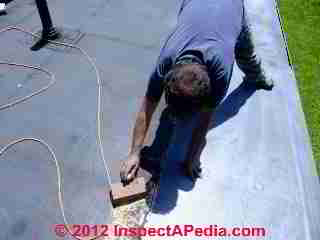
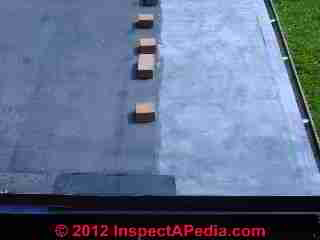
Following this EPDM repair we visited all of the existing seams on the remaining original roof (upper slope sections), cleaning and re-sealing any seams that appeared at all suspicious. We also closed and sealed (or re-sealed) all of the EPDM seam edges with EPDM lap sealant as a final step.
...
Reader Comments, Questions & Answers About The Article Above
Below you will find questions and answers previously posted on this page at its page bottom reader comment box.
Reader Q&A - also see RECOMMENDED ARTICLES & FAQs
On 2020-10-21 by Anon: EPDM patch choice
RE-posting:
reader follow-up:
I've decided to use a mule hide product similar to your swimming pool reference. Unfortunately, I found many labels that state their products can be used on epdm when they shouldn't be (asphalt, reactive polymers, etc). I will see if it passes the test & let you know.
Moderator reply:
You are so right;
Earlier this month I spent two days scraping up an asphalt-based seam sealer that was used on an EPDM roof (and failed). It was a bear to clean-off in order to make a proper repair.
If your leak is a small one, an EPDM pond liner patch kit may work.
On 2020-10-19 by (mod)
Below are the conditions under the tarp at the time of the leak back in 2018
On 2020-10-19 by (mod) - tarp over a leaky EPDM roof?
 RE-posting from private email:
RE-posting from private email:
Fixing an EPDM roof leak in wet weather:
Anonymous asked:
I'm debating on proper action. An epdm leak while it's raining, to stop leaks. Tarp area or use a product that cures in the rain?
- 2020/10/20
Moderator reply:
I've used the tarp approach but only where I could cover so much of the roof OR arrange the tarp to give some slope for drainage and then seal down its edges so that I was certain I'd not just have water from elsewhere on the low-slope leaking under my tarp and into the leak spot.
Certainly there are products that will cure when wet - swimming pool repair people use them under-water; but the surface has to be clean of algae and debris.
In my photo below you can see that during rainy weather I had jury-rigged whatever tarps and junk were at-hand to set up tarps to cover and drain off of an EPDM roof that was leaking near its lower edge. I covered the whole roof section, used boards and ladders and whatever I could find to get some slope, and to minimize sagging in my tarps, to which I had to add ballast so the whole thing wouldn't blow off the roof.
This worked to keep the homeowners dry until we could fix the roof in better weather - which is a factor.
So the answer is: it depends.
If your leak is a small seam opening, sure go ahead and patch with wet-sealing materials.
But if you find, as I did, that the roof insulation and decking were soaked, sagging, and needing replacement, I figured I could do a much better job in dry weather.
On 2020-09-15 by Bill Stark
Thanks for the reply.
On 2020-09-15 - by (mod) -
repair soft area under the EDPM roof on the slide out of my park model RV trailer.Bill
I've done this sort of repair and warn that while it's important to do the repair and stop leaks,
- the membrane is usually glued to the roof deck - you'll need to do some serious pulling to remove the EPDM far enough back from the damage area to get to sound decking,
- remove and replace wet materials like insulation or ceiling paneling or drywall that can't be cleaned
- replace the bad decking
- re-glue the EPDM
- repair the seam with seam tape
- seal the seam tape edges with EPDM sealant (comes in a "caulk-type" tube) for a longer-lasting repair
Take care not to step through the roof.
On 2020-09-15 by Bill Stark
I need to repair soft area under the EDPM roof on the slide out of my park model RV trailer.
If I cut the membrane is it reasonable to expect that I can peal back the membrane to gain access to the damaged area , make the repairs to the wood substrate and then " reglue" the existing membrane and complete the repair with seam tape.
Your advice would be much appreciated
Thanks
On 2019-02-20 by Victoria Morgon
If you’ve discovered a leak, then don’t delay in taking action to rectify the situation. It may be a small problem now, but it will only become a bigger, more serious problem later if you fail to act. One of the best options for repairing EPDM Roof Leak is to use an EPDM coating.
On 2018-04-16 - by (mod) -
Yes bob with proper adhesive and/or fasteners.
On 2018-04-16 - by (mod) -
Lilly martians said:
The use of an improper drip edge can be the cause of your roof fall so always trust on Epdm resistance. It will never let you down.
On 2017-10-17 by bob
is it possible to lay a new rubber roof over an existing rubber roof .wordering if I can do this on my travel trailer
On 2016-10-15 by Mark
Should say EPDM. Was autocorrected.
On 2015-05-18 - by (mod) - glued-down EPDM sticks to fiber-type roof insulation decking: problems on removal
Jim
As my buddy Mark Cramer (Florida inspection professional) says, "It depends ,..." If the EPDM was glued to a hard substrate such as roof decking it'll be hell to remove
Watch out: if your EPDM was glued to a paper or foil faced insulating board you can peel it back but you'll find that you've peeled the skin off of the insulating board as well.
That could give adhesion problems for the new roof unless the board is replaced or layered-over.
On 2015-04-29 by Jim
Hi. I have a epdm roof about 12 years old which in the past has given trouble with slight leaks through the seamed joints. I am intending major cosmetic alterations to the dormer and think I would like to recover the roof with one piece epdm. My question is will the existing strips of epdm peel of the t&g substrate easily or will I be left with lots of patches.
I need to remove the epdm so I can use water based adhesive rather than try impact adhesive as the area is about 22 sq mts. Any feedback would be helpful Thanks
Question:
(Aug 15, 2012) jerry d said:
roof wrinkle was cut out and patched repaired. will the patch added hold against rain over several years?
Reply:
Yes if properly installed. The surfaces had to be clean and dry and the proper adhesive used.
Question:
(June 30, 2014) J Haynes said:
My roofer has just installed a new EPDM flat roof which 'ponds' over about a quarter when it rains. He says that this is normal. Is he right as the only way the water is displaced is by evaporation?
Reply:
Well not exactly ...
"Flat" roofs usually are very low slope and do indeed drain to a scupper, roof edge or other drain opening. They are not very often perfectly dead flat.
IF your roof has no standing water 24 hours after rainfall then it's considered to drain adequately.
Otherwise it is not draining adequately.
Question: drip edge specifications for flat & low slope roofs
I have a elastomeric roof with APOC 252 white on top of APOC 302 emulsion. The previous roof had a 2" gravel guard and the elastomeric is failing in the joints of the guard and the roof. Water is getting behing the fascia and rotting it. The roof is 5/12 pitch.
Planning on cutting back the fascia. shall I cut the fascia just below the coating level? It feels like I need a connector between the fascia nd the roofing material. Any suggestions?
Reply:
Hal we had this problem on an older EPDM roof, exacerbated by the presence of a gravel guard (with a raised edge) that kept water on the roof where it should have been allowed to drain. Gravel guards belong on tar and gravel roofs, not EPDM or elastomeric roofs.
After several annoying years and seeing the EPDM begin to lift at roof edges our solution was to cut back 12" of roofing from the lower roof edges, remove the gravel guard, install the proper (flat) roof drip edge, then glue down a new length of EPDM along the roof edge and atop the upper portion of the drip edge.
You can see that repair above on this page and further results in the article EPDM ROOF SEAM REPAIR TAPE
The drip edge should extend out about 1/4" from the fascia (vertical) surface so as to direct water off of the fascia rather than onto it.
Fix a Rubber Roof Leak using EPDM Rubber Roof Seam Tape
This discussion has moved to its own page, now found at
Coatings for EPDM Roof Repair or Life Extension
This topic has moved to a new separate article at EPDM ROOF COATING REPAIRS
A number of companies provide several types of coatings that are used for sealing or repairing flat and low slope roofs originally covered by an EPDM membrane.
Also see ROOF & WATERPROOFING MAINTENANCE & REPAIR, HUD Guidebook V, Chapter Five, [PDF] retrieved 2018/02/17, original source: https://www.hud.gov/sites/documents/HUDGB5C5GUID.PDF
...
Continue reading at EPDM ROOF SEAM REPAIR TAPE or select a topic from the closely-related articles below, or see the complete ARTICLE INDEX.
Or see these
Low Slope & Flat Roof Repair Articles
- BUILT UP ROOFS
- CONCRETE ROOFING
- DEFECTS LIST - ROOF LOW SLOPE
- EPDM, RUBBER, PVC ROOFING
- EPDM ROOF COATING REPAIRS
- EPDM ROOF LEAK REPAIRS
- EPDM ROOF SEAM REPAIR TAPE
- FLAT ROOF DRAINAGE SYSTEMS
- FLAT ROOF LEAK REPAIR
- FLAT ROOF MOISTURE & CONDENSATION
- LOW SLOPE ROOFING
- LOW SLOPE ROOF CONVERSION
- MEMBRANE & SINGLE PLY ROOFS
- MODIFIED BITUMEN ROOFING
- MODIFIED BITUMEN ROOF DEFECTS & ROOF LIFE
- ROLL ROOFING, ASPHALT & SBS
- ROOF LEAK SOURCE DIAGNOSIS
Suggested citation for this web page
EPDM ROOF LEAK REPAIRS at InspectApedia.com - online encyclopedia of building & environmental inspection, testing, diagnosis, repair, & problem prevention advice.
Or see this
INDEX to RELATED ARTICLES: ARTICLE INDEX to BUILDING ROOFING
Or use the SEARCH BOX found below to Ask a Question or Search InspectApedia
Ask a Question or Search InspectApedia
Try the search box just below, or if you prefer, post a question or comment in the Comments box below and we will respond promptly.
Search the InspectApedia website
Note: appearance of your Comment below may be delayed: if your comment contains an image, photograph, web link, or text that looks to the software as if it might be a web link, your posting will appear after it has been approved by a moderator. Apologies for the delay.
Only one image can be added per comment but you can post as many comments, and therefore images, as you like.
You will not receive a notification when a response to your question has been posted.
Please bookmark this page to make it easy for you to check back for our response.
IF above you see "Comment Form is loading comments..." then COMMENT BOX - countable.ca / bawkbox.com IS NOT WORKING.
In any case you are welcome to send an email directly to us at InspectApedia.com at editor@inspectApedia.com
We'll reply to you directly. Please help us help you by noting, in your email, the URL of the InspectApedia page where you wanted to comment.
Citations & References
In addition to any citations in the article above, a full list is available on request.
- Mark Cramer Inspection Services Mark Cramer, Tampa Florida, Mr. Cramer is a past president of ASHI, the American Society of Home Inspectors and is a Florida home inspector and home inspection educator. Mr. Cramer serves on the ASHI Home Inspection Standards. Contact Mark Cramer at: 727-595-4211 mark@BestTampaInspector.com
- John Cranor [Website: /www.house-whisperer.com ] is an ASHI member and a home inspector (The House Whisperer) is located in Glen Allen, VA 23060. He is also a contributor to InspectApedia.com in several technical areas such as plumbing and appliances (dryer vents). Contact Mr. Cranor at 804-873-8534 or by Email: johncranor@verizon.net
- Eric Galow, Galow Homes, Lagrangeville, NY. Mr. Galow can be reached by email: ericgalow@gmail.com or by telephone: 914-474-6613. Mr. Galow specializes in residential construction including both new homes and repairs, renovations, and additions.
- "Choosing Roofing," Jefferson Kolle, January 1995, No. 92, Fine Homebuilding, Taunton Press, 63 S. Main St., PO Box 5506, Newton CT 06470 - 800-888-8286 - see http://www.taunton.com/FineHomebuilding/ for the magazine's website and for subscription information.
- Low Slope Roofing, Manual of, 4th Ed., C.W. Griffin, Richard Fricklas,
McGraw-Hill Professional; 4 edition, 2006, ISBN-10: 007145828X, ISBN-13: 978-0071458283
- Roof failure causes in depth (and specific methods for avoiding them)
- Roof design fundamentals and flourishes, based on voluminous industry research and experience
- New technologies and materials -- using them safely and correctly
- Comprehensive coverage of all major roofing systems pecifications, inspection, and maintenance tools for roofing wor
- Building Pathology, Deterioration, Diagnostics, and Intervention, Samuel Y. Harris, P.E., AIA, Esq., ISBN 0-471-33172-4, John Wiley & Sons, 2001 [General building science-DF] ISBN-10: 0471331724 ISBN-13: 978-0471331728
- Building Pathology: Principles and Practice, David Watt, Wiley-Blackwell; 2 edition (March 7, 2008) ISBN-10: 1405161035 ISBN-13: 978-1405161039
- Problems in Roofing Design, B. Harrison McCampbell, Butterworth Heineman, 1991 ISBN 0-7506-9162-X (available used)
- Our recommended books about building & mechanical systems design, inspection, problem diagnosis, and repair, and about indoor environment and IAQ testing, diagnosis, and cleanup are at the InspectAPedia Bookstore. Also see our Book Reviews - InspectAPedia.
- Best Practices Guide to Residential Construction, by Steven Bliss. John Wiley & Sons, 2006. ISBN-10: 0471648361, ISBN-13: 978-0471648369, Hardcover: 320 pages, available from Amazon.com and also Wiley.com. See our book review of this publication.
- Decks and Porches, the JLC Guide to, Best Practices for Outdoor Spaces, Steve Bliss (Editor), The Journal of Light Construction, Williston VT, 2010 ISBN 10: 1-928580-42-4, ISBN 13: 978-1-928580-42-3, available from Amazon.com
- The Journal of Light Construction has generously given reprint permission to InspectAPedia.com for this article. All rights and contents are ©Journal of Light Construction and may not be reproduced in any form.
- Building Pathology, Deterioration, Diagnostics, and Intervention, Samuel Y. Harris, P.E., AIA, Esq., ISBN 0-471-33172-4, John Wiley & Sons, 2001 [General building science-DF] ISBN-10: 0471331724 ISBN-13: 978-0471331728
- Problems in Roofing Design, B. Harrison McCampbell, Butterworth Heineman, 1991 ISBN 0-7506-9162-X (available used)
- Roofing The Right Way, Steven Bolt, McGraw-Hill Professional; 3rd Ed (1996), ISBN-10: 0070066507, ISBN-13: 978-0070066502
- Smart Guide: Roofing: Step-by-Step Projects, Creative Homeowner (Ed), 2004, ISBN-10: 1580111491, ISBN-13: 978-1580111492
- In addition to citations & references found in this article, see the research citations given at the end of the related articles found at our suggested
CONTINUE READING or RECOMMENDED ARTICLES.
- Carson, Dunlop & Associates Ltd., 120 Carlton Street Suite 407, Toronto ON M5A 4K2. Tel: (416) 964-9415 1-800-268-7070 Email: info@carsondunlop.com. Alan Carson is a past president of ASHI, the American Society of Home Inspectors.
Thanks to Alan Carson and Bob Dunlop, for permission for InspectAPedia to use text excerpts from The HOME REFERENCE BOOK - the Encyclopedia of Homes and to use illustrations from The ILLUSTRATED HOME .
Carson Dunlop Associates provides extensive home inspection education and report writing material. In gratitude we provide links to tsome Carson Dunlop Associates products and services.


